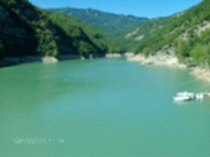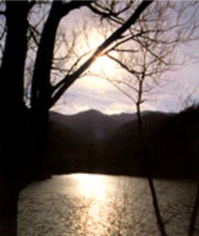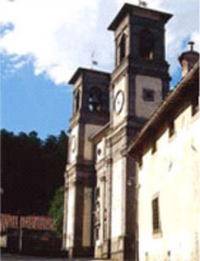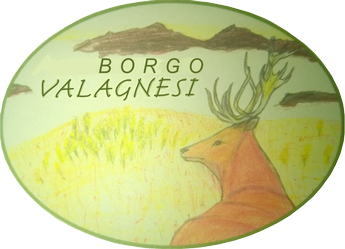Park
Il Parco Nazionale Foreste Casentinesi
(Casentino Forest National Park, Villages in the Park & Villages in the Park)
Storie di uomini e santi - I Paesi del Parco

Un paradiso naturalistico a cavallo tra due regioni, dove a cacciare cervi e caprioli è tornato il lupo. Un'oasi di verde, nel cui cuore da secoli comunità di monaci coltivano il silenzio. A naturalistic paradise between two regions (Toscana e Romagna), where wolf is back to hunt deer and roe deer. A green oasis, where for centuries monk communities has been cultivating silence.
Questo è il parco più verde d'Italia, le foreste coprono circa l’80% della sua superficie e l'intera zona è ricca di corsi d'acqua. Bidente, Rabbi e Montone sono i nomi dei fiumi che solcano le valli romagnole. Dalla parte toscana nella zona del Casentino nasce l'Arno ( Monte Falterona), con i suoi affluenti Staggia, Fiumicello e Archiano. Presso Ridracoli, dove ha sede uno dei musei naturalistici presenti nell'area del parco, dal 1982 una diga eretta per fornire energia e acqua potabile ai Comuni della pianuraRomagnola ha creato un suggestivo invaso artificiale, frequentato da diverse specie di uccelli. una suggestiione particolare ce la regalano le cascate del fosso dell'Acquacheta, descritte da Dante nel XVI canto dell'Inferno, oppure quelle degli Scalandrini ed altre, che d'inverno si trasformano in straordinari arabeschi di ghiaccio.
This is the greenest park in Italy, covering forests for about 80% out of its surface and the whole area is plenty of water courses. These rivers that cross Romagna valleys are called Bidente, Rabbi and Montone. As far as Tuscan part is concerned, there are small courses on the left side of river Arno, such as the streams called Staggia, Fiumicello and Archiano. At Ridracoli, where you can find one of the several museum of the park, since 1982, it has been creating a dike built to give energy and drinking water to the municipalities of pianura Romagnola, an impressive artificial lake. Nowadays there you may easily find several species of birds. The sight of Acquacheta Falls are even more charming - they are described in Dante's Hell; Chant XVI - or those in Scalandrini and so on. In winter they also turn into wonderful frost traceries.
Assai varia e ricca è la flora, contando all'incirca 1.200 specie. Nelle aree più calde e aride vivono specie mediterranee, che si aggiungono alle più diffuse specie a distribuzione europea. Ma ai botanici questi boschi riservano continue sorprese, come testimoniano le scoperte di svariate classificazioni di nuove specie vegetali, come per esempio di recenti scoperte di nuove felci ed orchidee.
Flora is quite various and rich: indeed there are about 1200 species. In the warmest and driest areas there are also some Mediterranean species to add those - more renowned - that are in Europe. But to botanists, these woods are full of discoveries, as the recent evidences of a rare fern and a new orchid may confirm.
 Nel parco, oltre a moltissime altre specie di animali, vivono quattro specie di ungulati:caprioli, cervi, daini e cinghiali. Presenti,complessivamente per un numero di circa 50.000 esemplari, il capriolo vive nell'intera area del parco. Il suo numero è contenuto innanzitutto dalla predazione da parte del lupo, ma pure dagli inverni rigidi e dalla competizione del cervo. Il daino è stato introdotto a partire dal 1835 per le battute di caccia del granduca Leopoldo II. Da allora si è moltiplicato, soprattutto alle quote inferiori del versante romagnolo del parco, e oggi i danni causati nei campi gli hanno guadagnato l'ostilità dei coltivatori. Pure introdotto era il muflone, negli anni Cinquanta e Sessanta, stavolta dalla Forestale: ma attualmente sembra che non ce ne siano più, dopo il ritorno del lupo di cui ha evidentemente rappresentato un'appetibile preda in virtù del suo scarso adattamento a simili ambienti. Quanto al cinghiale, assente fino a vent'anni fa dall'area del parco, vi è stato reintrodotto nei primi anni Settanta a scopo venatorio e oggi è la principale preda del lupo.
Nel parco, oltre a moltissime altre specie di animali, vivono quattro specie di ungulati:caprioli, cervi, daini e cinghiali. Presenti,complessivamente per un numero di circa 50.000 esemplari, il capriolo vive nell'intera area del parco. Il suo numero è contenuto innanzitutto dalla predazione da parte del lupo, ma pure dagli inverni rigidi e dalla competizione del cervo. Il daino è stato introdotto a partire dal 1835 per le battute di caccia del granduca Leopoldo II. Da allora si è moltiplicato, soprattutto alle quote inferiori del versante romagnolo del parco, e oggi i danni causati nei campi gli hanno guadagnato l'ostilità dei coltivatori. Pure introdotto era il muflone, negli anni Cinquanta e Sessanta, stavolta dalla Forestale: ma attualmente sembra che non ce ne siano più, dopo il ritorno del lupo di cui ha evidentemente rappresentato un'appetibile preda in virtù del suo scarso adattamento a simili ambienti. Quanto al cinghiale, assente fino a vent'anni fa dall'area del parco, vi è stato reintrodotto nei primi anni Settanta a scopo venatorio e oggi è la principale preda del lupo. In the Park, apart the numerous species of animals, four ungulates live there: roe deer, deer, fallow deer and wild boars. There are about 50,000 roe deer in the whole area of the Park. Roe deer exemplars are few because of the predation by wolf and also because of harsh winters and the contests of deer. Fallow deer has been introduced since 1835 because of Grand Duke Leopoldo II's hunting. Since then, it has been reproducing and above all, in the lowest parts of Romagna area of the Park. Nowadays, farmers hate the fallow deer for the damages it causes in the fields. Also moufflon was introduced during the 50's and 60's by the Corps of foresters, but nowadays it seems it has been vanished for its weak adaptability in the environment and after the coming back of wolf. As regards wild boar in the park area, there was no trace until twenty years ago. During the early 70's, it has been reintroduced for hunting and nowadays it is the main prey of wolf.
Vi sono anche tante altre specie minori, non meno importanti, come ad esempio per le zone umide: Germano Reale, Tritoni, Salamandre ecc
There are also many other minor species, no less important, such as for the wetlands: Germano Reale, Tritons, Salamanders etc.
Una spiritualità profonda che vive in antichi e famosi conventi, luoghi di pace esilenzio dove da secoli si guarda alla natura. Piccole e grandi storie, vicende di nobili casate e quotidianità della gente dei monti e dei boschi. All'interno del Parco si trovano tante testimonianze di storia, d'arte, di vita e alcuni centri di fede e cultura capaci di parlare al mondo.
You may find a deep spirituality in ancient convents, places of peace and silence where for centuries nature has been the main aim. Small and great stories, events of noble families and everyday life of those who lived in the mountains or woods. Inside the Park, numerous are the evidences of history, art, life and centers of faith an culture able to speak to the world.

Il Monastero e l'Eremo di Camaldoli: "tu sarai abete per altezza di contemplazione" La fede e un rapporto particolare con la natura hanno dato vita ad una storia che ha più di mille anni.
La tradizione fa risalire al 1012 la fondazione dell'Eremo ad opera di S. Romualdo che visitando questi luoghi ..... stesse alquanto fermo, appoggiato ad un bastone che egli portava: guardando ora in questa, or in quella parte, perché non si vedeva se non il cielo e in terra altro che arbori altissimi, e si sentivano alcuni uccelli cantare che aiutavano la contemplazione e facevano che più piacesse il silenzio di quella solitudine.
The Monastery and the Hermitage of Camaldoli: "You will be fir because your highness in contemplation". The faith and a special relationship with nature gave life to a story that is almost a thousand years old.
The tradition establishes the institution of the Hermitage in 1012 by St. Romualdo who visiting those places … quite still and leant to his stick: now looking there, then in the opposite side because everything but the sky was visible and on the ground, only high trees and birds singing, so helping the contemplation and the admiration for that silence and loneliness.
La Congregazione Camaldolese ebbe un ruolo importantissimo in epoca medioevale, fondò numerosi monasteri ed acquisì possedimenti sia in Italia che al di là delle Alpi. Esercitò il controllo temporale su un vasto territorio del Casentino, dedicando sempre particolare cura alla ricchissima foresta che circonda l'Eremo e il Monastero. Anche ai nostri giorni Camaldoli, oltre ad essere luogo centrale per numerose escursioni nel Parco, è un punto di riferimento religioso di importanza internazionale, meta di pellegrini e visitatori che possono immergersi nelle atmosfere serene del Monastero e in quelle più mistiche e rarefatte dell'Eremo, con le celle e il muro perimetrale di mille abeti mille volte cinto.
Camaldolese Congregation had a great role during Medieval times and established numerous monasteries and got estates both in Italy and beyond the Alps. It pursued a temporal command over a wide area of Casentino, always taking a great care for the prosperous forest that surrounds the Hermitage and the Monastery. Also nowadays Camaldoli is not only the perfect centre for numerous excursions in the Park but also it is a religious landmark of international worth, destination of pilgrims and travelers that may dip in the serene atmospheres of the Monastery and in those more mystic and rarefied of the Hermitage, with its cells and boundary wall made up of a thousand trees and thousand times enclosed.
La Verna: "altro monte non ha più santo il mondo" Santuario caro a tutta la Cristianità, rifugio umile e immerso tra le selve dove S. Francesco visse e ricevette le Stimmate, luogo carico di una bellezza profonda e quasi soprannaturale. Fin dal 1214 i frati hanno protetto il monte su cui sorge il Santuario, un monte ricco di grotte, anfratti, rocce, dove la rigogliosa vegetazione è stata lasciata alla vita spontanea. La Verna, per la sua fama e per l'indubbia suggestione che esercita su chiunque, è meta di pellegrini e visitatori provenienti da tutto il mondo che apprezzano i suoi potenti segni e messaggi di fede e le tante opere d'arte raccolte tra le mura del Santuario.
Segni della storia, segni dell' arte: antichi, ricchi, ovunque. In tutti i paesi del Parco e delle vallate vicine si trovano castelli, palazzi, piazze e mura che ricordano gli splendori medioevali e rinascimentali vissuti in questi lembi di Toscana e di Romagna. Chiese, pievi romaniche, torri, borghi fortificati, antichi ponti fanno il paesaggio, riempiono gli occhi e i pensieri di ogni visitatore.
La Verna: "the world has no mountains so sacred". A holy Sanctuary to all the Christianity, it is a humble refuge immersed in the woods where St. Francis lived and received the Stigmata. It is a place full of a deep wonder and almost mystic. Since 1214 frails sheltered the mountain where the Sanctuary is set: a mountain with numerous caves, gorges, crags and where the rich vegetation has been left spontaneous. La Verna, thanks to its notoriety and its undoubted charming that engages in everybody, it is the destination of pilgrims and travelers coming from all over the world that love its powerful signs and messages of faith and the numerous masterpieces gathered in the Sanctuary.
Signs of history, signs of art: ancient and copious, everywhere. In every village of the Park of the near valleys you may find castles, palaces and walls reminding the ancient splendors of the Medieval and Renaissance times that took place in these areas of Tuscany and Emila-Romagna. Churches, parishes, towers, fortified villages, ancient bridges draw this landscape and give wonder to every travelers’ eyes and thoughts.

BIBBIENA
La cittadina costituisce uno dei centri più importanti del casentino. Vi si trovano il rinascimentale Palazzo Dovizi, la quattrocentesca Chiesa di San Lorenzo contenente due capolavori di Andrea della Robbia, L'Oratorio di San Lorenzo, la Chiesa dei SS. Ippolito e Donato. Nelle vicinanze del centro è da visitare il Santuario di Santa Maria del Sasso Nel territorio del comune, si trova la ridente frazione di Serravalle dominata dell'antico Castello del XII secolo.
The town is one of the most important centers of Casentino. There are the Renaissance Palazzo Dovizi, the fifteenth-century Church of San Lorenzo with two masterpieces by Andrea della Robbia, The Oratory of San Lorenzo, the Church of SS. Ippolito and Donato. Near the center is worth visiting the Sanctuary of Santa Maria del Sasso. In the territory of the municipality, it is the nice suburb of Serravalle dominated by the ancient castle of the twelfth century.
POPPI
Poppi importante borgo mediovale, è elencato tra i “Borghi più belli d’Italia”. Vi si trova il Castello dei Conti Guidi uno dei più importanti esempi di architettura medievale e una delle principali mete turistiche della Toscana. Vi sono tante altre opere storiche e artistiche di rilievo e luoghi di culto. A Poppi si trova anche il primo Parco zoo di fauna Europea.
Poppi important medieval village, is listed among the "Most Beautiful Villages of Italy". There is the Castle of the Counts Guidi one of the most important examples of medieval architecture and one of the main tourist attractions of Tuscany. There are many other works of historical and artistic importance and religious sites. A Poppi is located also the first Zoo Park of European wildlife.

.





